Analytical Study of Porous Organosilicate Glass Films Prepared from Mixtures of 1,3,5- and 1,3-Alkoxysilylbenzenes
Abstract
:1. Introduction
2. Materials and Methods
2.1. Materials
2.2. Characterization
3. Results and Discussion
3.1. Molecular Structure of 135TTEB-Bridged Precursor
3.2. Influence of 135TTEB and 13BTEB Bridge Group Ratio and Curing Ambient on the Properties of OSG Low-k Films
3.3. Change of Thickness and Refractive Index on Curing in Air and N2 for Different Molar Ratio (1:3 and 1:7) Benzene-Bridged OSG Films
3.4. Chemical Composition of (135TTEB:13BTEB = 1:3 and 1:7) Benzene-Bridged OSG Films
3.5. Porosity and Pore Size Distribution (Ellipsometric Porosimetry Data)
3.6. Young’s Modulus and Dielectric Constant
3.7. Hydrophobicity and Hydrophilicity of the Films Surface
3.8. Effect of Storage
3.9. Thermal Stability
3.10. UV-Induced Photoluminescence (PL)
4. Conclusions
Supplementary Materials
Author Contributions
Funding
Institutional Review Board Statement
Informed Consent Statement
Data Availability Statement
Acknowledgments
Conflicts of Interest
References
- Maex, K.; Baklanov, M.R.; Shamiryan, D.; Lacopi, F.; Brongersma, S.H.; Yanovitskaya, Z.S. Low dielectric constant materials for microelectronics. J. Appl. Phys. 2003, 93, 8793–8841. [Google Scholar] [CrossRef]
- Grill, A. PECVD low and ultralow dielectric constant materials: From invention and research to products. J. Vac. Sci. Technol. B Nanotechnol. Microelectron. Mater. Process. Meas. Phenom 2016, 34, 020801. [Google Scholar] [CrossRef]
- Baklanov, M.R.; Ho, P.S.; Zschech, E. (Eds.) Advanced Interconnects for ULSI Technology; John Wiley & Sons: Chichester, UK, 2012; ISBN 9781119963677. [Google Scholar]
- Baklanov, M.R.; Adelmann, C.; Zhao, L.; De Gendt, S. Advanced Interconnects: Materials, Processing, and Reliability. ECS J. Solid State Sci. Technol. 2015, 4, Y1–Y4. [Google Scholar] [CrossRef]
- Volksen, W.; Miller, R.D.; Dubois, G. Low Dielectric Constant Materials. Chem. Rev. 2010, 110, 56–110. [Google Scholar] [CrossRef]
- Eslava, S.; Zhang, L.; Esconjauregui, S.; Yang, J.; Vanstreels, K.; Baklanov, M.R.; Saiz, E. Metal-Organic Framework ZIF-8 Films As Low-κ Dielectrics in Microelectronics. Chem. Mater. 2013, 25, 27–33. [Google Scholar] [CrossRef]
- Hong, S.; Lee, C.-S.; Lee, M.-H.; Lee, Y.; Ma, K.Y.; Kim, G.; Yoon, S.I.; Ihm, K.; Kim, K.-J.; Shin, T.J.; et al. Ultralow-dielectric-constant amorphous boron nitride. Nature 2020, 582, 511–514. [Google Scholar] [CrossRef] [PubMed]
- Volksen, W.; Lionti, K.; Magbitang, T.P.; Dubois, G. Hybrid low dielectric constant thin films for microelectronics. Scr. Mater. 2014, 74, 19–24. [Google Scholar] [CrossRef]
- Kopycinska-Müller, M.; Clausner, A.; Yeap, K.-B.; Köhler, B.; Kuzeyeva, N.; Mahajan, S.; Savage, T.; Zschech, E.; Wolter, K.-J. Mechanical characterization of porous nano-thin films by use of atomic force acoustic microscopy. Ultramicroscopy 2016, 162, 82–90. [Google Scholar] [CrossRef] [Green Version]
- Lionti, K.; Volksen, W.; Magbitang, T.; Darnon, M.; Dubois, G.; Lyu, Y.-R.; Hsieh, T.-E. Toward Successful Integration of Porous Low-k Materials: Strategies Addressing Plasma Damage. ECS J. Solid State Sci. Technol. 2015, 4, N3071–N3083. [Google Scholar] [CrossRef] [Green Version]
- Vanstreels, K.; Li, H.; Vlassak, J.J. Mechanical Reliability of Low-k Dielectrics. In Advanced Interconnects for ULSI Technology; Wiley: Chichester, UK, 2012; pp. 339–367. ISBN 9780470662540. [Google Scholar]
- Bruce, R.L.; Engelmann, S.; Purushothaman, S.; Volksen, W.; Frot, T.J.; Magbitang, T.; Dubois, G.; Darnon, M. Investigation of plasma etch damage to porous oxycarbosilane ultra low-kdielectric. J. Phys. D Appl. Phys. 2013, 46, 265303. [Google Scholar] [CrossRef]
- Dag, Ö.; Yoshina-Ishii, C.; Asefa, T.; MacLachlan, M.J.; Grondey, H.; Coombs, N.; Ozin, G.A. Oriented Periodic Mesoporous Organosilica (PMO) Film with Organic Functionality Inside the Channel Walls. Adv. Funct. Mater. 2001, 11, 213–217. [Google Scholar] [CrossRef]
- Dubois, G.; Volksen, W.; Magbitang, T.; Sherwood, M.H.; Miller, R.D.; Gage, D.M.; Dauskardt, R.H. Superior mechanical properties of dense and porous organic/inorganic hybrid thin films. J. Sol Gel Sci. Technol. 2008, 48, 187–193. [Google Scholar] [CrossRef]
- Kim, S.; Toivola, Y.; Cook, R.F.; Char, K.; Chu, S.-H.; Lee, J.-K.; Yoon, D.Y.; Rhee, H.-W. Organosilicate Spin-on Glasses. J. Electrochem. Soc. 2004, 151, F37–F44. [Google Scholar] [CrossRef]
- Hoffmann, F.; Cornelius, M.; Morell, J.; Fröba, M. Silica-based mesoporous organic-inorganic hybrid materials. Angew. Chem. Int. Ed. 2006, 45, 3216–3251. [Google Scholar] [CrossRef] [PubMed]
- Dubois, G.; Volksen, W.; Magbitang, T.; Miller, R.D.; Gage, D.M.; Dauskardt, R.H. Molecular Network Reinforcement of Sol—Gel Glasses. Adv. Mater. 2007, 19, 3989–3994. [Google Scholar] [CrossRef]
- Li, H.; Knaup, J.M.; Kaxiras, E.; Vlassak, J.J. Stiffening of organosilicate glasses by organic cross-linking. Acta Mater. 2011, 59, 44–52. [Google Scholar] [CrossRef]
- Redzheb, M.; Armini, S.; Berger, T.; Jacobs, M.; Krishtab, M.; Vanstreels, K.; Bernstorff, S.; Van Der Voort, P. On the mechanical and electrical properties of self-assembly-based organosilicate porous films. J. Mater. Chem. C 2017, 5, 8599–8607. [Google Scholar] [CrossRef]
- Oliver, M.S.; Dubois, G.; Sherwood, M.; Gage, D.M.; Dauskardt, R.H. Molecular Origins of the Mechanical Behavior of Hybrid Glasses. Adv. Funct. Mater. 2010, 20, 2884–2892. [Google Scholar] [CrossRef]
- Burg, J.A.; Oliver, M.S.; Frot, T.J.; Sherwood, M.; Lee, V.; Dubois, G.; Dauskardt, R.H. Hyperconnected molecular glass network architectures with exceptional elastic properties. Nat. Commun. 2017, 8, 1019. [Google Scholar] [CrossRef] [Green Version]
- Kilic, K.I.; Dauskardt, R.H. Design of Ultrastiff Organosilicate Hybrid Glasses. Adv. Funct. Mater. 2019, 29, 1904890. [Google Scholar] [CrossRef]
- Kilic, K.I.; Dauskardt, R.H. Mechanically reliable hybrid organosilicate glasses for advanced interconnects. J. Vac. Sci. Technol. B 2020, 38, 060601. [Google Scholar] [CrossRef]
- Seregin, D.S.; Naumov, S.; Chang, W.-Y.; Wu, Y.-H.; Wang, Y.; Kotova, N.M.; Vishnevskiy, A.S.; Wei, S.; Zhang, J.; Vorotilov, K.A.; et al. Effect of the C-bridge on UV properties of organosilicate films. Thin Solid Films 2019, 685, 329–334. [Google Scholar] [CrossRef]
- Liu, C.; Lv, C.; Koehler, N.; Wang, X.; Lin, H.; He, Z.; Wu, Y.-H.; Leu, J.; Wei, S.; Zhang, J.; et al. Properties of organosilicate low-k films with 1,3- and 1,3,5-benzene bridges between Si atoms. Jpn. J. Appl. Phys. 2020, 59, SLLG01. [Google Scholar] [CrossRef]
- Baklanov, M.R.; Mogilnikov, K.P.; Polovinkin, V.G.; Dultsev, F.N. Determination of pore size distribution in thin films by ellipsometric porosimetry. J. Vac. Sci. Technol. B Microelectron. Nanometer Struct. 2000, 18, 1385. [Google Scholar] [CrossRef]
- Gregg, S.J.; Sing, K.S.W.; Salzberg, H.W. Adsorption Surface Area and Porosity. J. Electrochem. Soc. 1967, 114, 279. [Google Scholar] [CrossRef]
- Mogilnikov, K.P.; Baklanov, M.R. Determination of Young’s Modulus of Porous Low-k Films by Ellipsometric Porosimetry. Electrochem. Solid State Lett. 2002, 5, F29. [Google Scholar] [CrossRef]
- Bennevault-Celton, V.; Maciejak, O.; Desmazières, B.; Cheradame, H. Condensation of alkoxysilanes in alcoholic media: II. Oligomerization of aminopropylmethyldiethoxysilane and co-oligomerization with dimethyldiethoxysilane. Polym. Int. 2010, 59, 1273–1281. [Google Scholar] [CrossRef]
- Krishtab, M.; de Marneffe, J.-F.; De Gendt, S.; Baklanov, M.R. Plasma induced damage mitigation in spin-on self-assembly based ultra low-k dielectrics using template residues. Appl. Phys. Lett. 2017, 110, 013105. [Google Scholar] [CrossRef] [Green Version]
- Launer, P.J.; Arkles, B. Infrared Analysis of Orgaonsilicon Compounds. In Silicon Compounds: Silanes Silicones, 3rd ed.; Gelest, Inc.: Morrisville, NY, USA, 2013. [Google Scholar]
- Blin, J.L.; Carteret, C. Investigation of the Silanols Groups of Mesostructured Silica Prepared Using a Fluorinated Surfactant: Influence of the Hydrothermal Temperature. J. Phys. Chem. C 2007, 111, 14380–14388. [Google Scholar] [CrossRef]
- Griffiths, P.R. The Handbook of Infrared and Raman Characteristic Frequencies of Organic Molecules. Vib. Spectrosc. 1992, 4, 121. [Google Scholar] [CrossRef]
- Nenashev, R.; Wang, Y.; Liu, C.; Kotova, N.; Vorotilov, K.; Zhang, J.; Wei, S.; Seregin, D.; Vishnevskiy, A.; Leu, J.; et al. Effect of Bridging and Terminal Alkyl Groups on Structural and Mechanical Properties of Porous Organosilicate Films. ECS J. Solid State Sci. Technol. 2017, 6, N182–N188. [Google Scholar] [CrossRef] [Green Version]
- Rasadujjaman, M.; Wang, Y.; Zhang, L.; Naumov, S.; Attallah, A.G.; Liedke, M.O.; Koehler, N.; Redzheb, M.; Vishnevskiy, A.S.; Seregin, D.S.; et al. A detailed ellipsometric porosimetry and positron annihilation spectroscopy study of porous organosilicate-glass films with various ratios of methyl terminal and ethylene bridging groups. Microporous Mesoporous Mater. 2020, 306, 110434. [Google Scholar] [CrossRef]
- Wang, X.; Liu, L.-T.; He, P.; Qu, X.-P.; Zhang, J.; Wei, S.; Mankelevich, Y.A.; Baklanov, M.R. Study of CoTa alloy as barrier layer for Cu/low-kinterconnects. J. Phys. D Appl. Phys. 2017, 50, 405306. [Google Scholar] [CrossRef]
- Vanstreels, K.; Wu, C.; Gonzalez, M.; Schneider, D.; Gidley, D.; Verdonck, P.; Baklanov, M.R. Effect of Pore Structure of Nanometer Scale Porous Films on the Measured Elastic Modulus. Langmuir 2013, 29, 12025–12035. [Google Scholar] [CrossRef]
- Vishnevskiy, A.S.; Naumov, S.; Seregin, D.S.; Wu, Y.-H.; Chuang, W.-T.; Rasadujjaman, M.; Zhang, J.; Leu, J.; Vorotilov, K.A.; Baklanov, M.R. Effects of methyl terminal and carbon bridging groups ratio on critical properties of porous organosilicate-glass films. Materials 2020, 13, 4484. [Google Scholar] [CrossRef] [PubMed]
- Chen, Y.; Pan, F.; Guo, Z.; Liu, B.; Zhang, J. Stiffness threshold of randomly distributed carbon nanotube networks. J. Mech. Phys. Solids 2015, 84, 395–423. [Google Scholar] [CrossRef]
- Snarskii, A.A.; Shamonin, M.; Yuskevich, P. Effective Medium Theory for the Elastic Properties of Composite Materials with Various Percolation Thresholds. Materials 2020, 13, 1243. [Google Scholar] [CrossRef] [PubMed] [Green Version]
- O’Sullivan, D.G. Frequencies of out-of-plane CH deformations of benzene rings which are fused to five-membered rings. Spectrochim. Acta 1960, 16, 762–764. [Google Scholar] [CrossRef]
- Raghavachari, K.; Ricci, D.; Pacchioni, G. Optical properties of point defects in SiO2 from time-dependent density functional theory. J. Chem. Phys. 2002, 116, 825–831. [Google Scholar] [CrossRef]
- Skuja, L.N.; Streletsky, A.N.; Pakovich, A.B. A new intrinsic defect in amorphous SiO2: Twofold coordinated silicon. Solid State Commun. 1984, 50, 1069–1072. [Google Scholar] [CrossRef]
- Rasadujjaman, M.; Zhang, J.; Mogilnikov, K.P.; Vishnevskiy, A.S.; Zhang, J.; Baklanov, M.R. Effect of methyl terminal and ethylene bridging groups on porous organosilicate glass films: FTIR, ellipsometric porosimetry, luminescence dataset. Data Brief 2021, 35, 106895. [Google Scholar] [CrossRef] [PubMed]
- Perevalov, T.V.; Gismatulin, A.A.; Seregin, D.S.; Wang, Y.; Xu, H.; Kruchinin, V.N.; Spesivcev, E.V.; Gritsenko, V.A.; Nasyrov, K.A.; Prosvirin, I.P.; et al. Critical properties and charge transport in ethylene bridged organosilica low-κ dielectrics. J. Appl. Phys. 2020, 127, 195105. [Google Scholar] [CrossRef]
- Perevalov, T.V.; Gismatulin, A.A.; Dolbak, A.E.; Gritsenko, V.A.; Trofimova, E.S.; Pustovarov, V.A.; Seregin, D.S.; Vorotilov, K.A.; Baklanov, M.R. Charge Transport Mechanism and Trap Origin in Methyl-Terminated Organosilicate Glass Low-κ Dielectrics. Phys. Status Solidi 2021, 218, 2000654. [Google Scholar] [CrossRef]
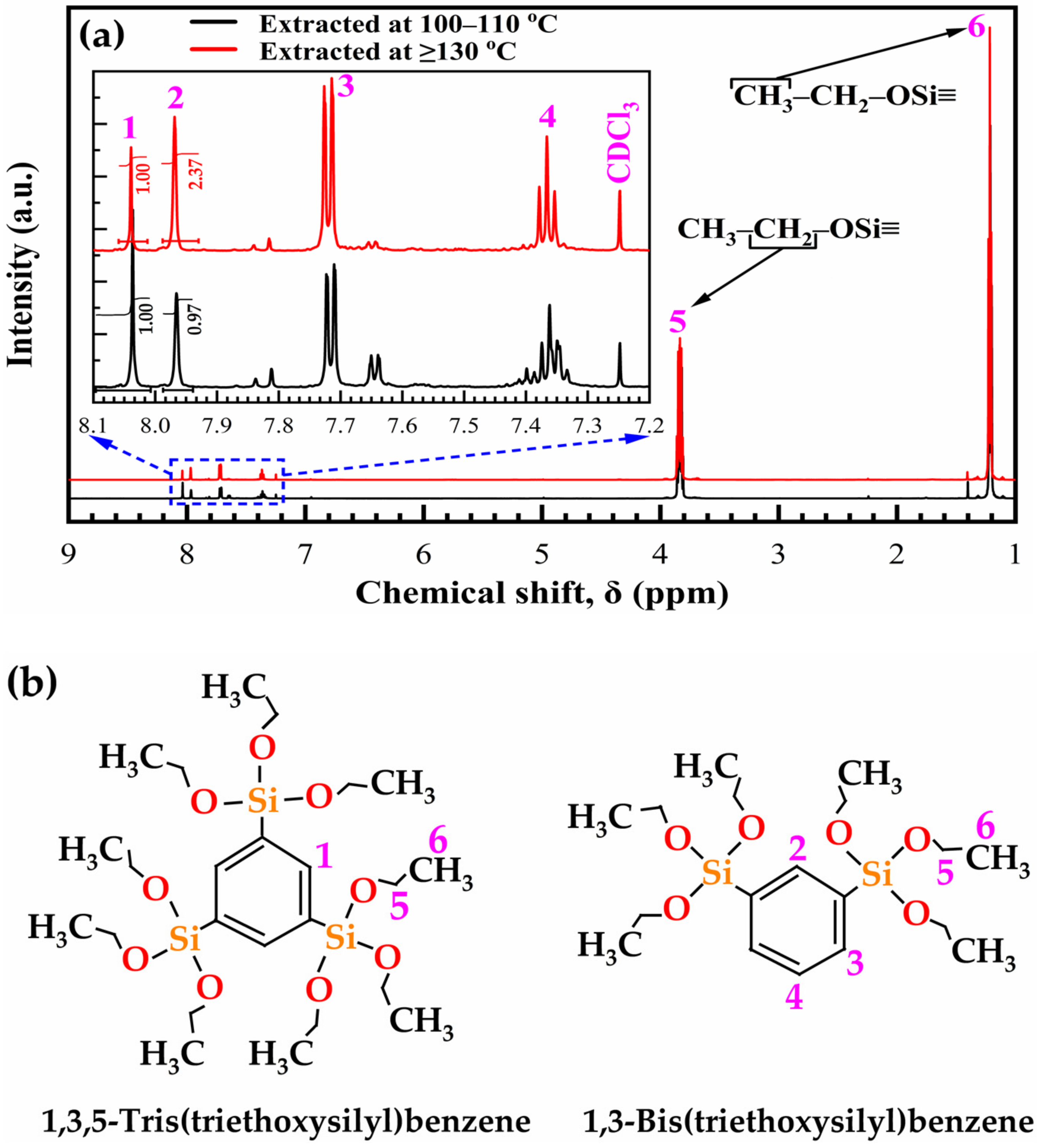

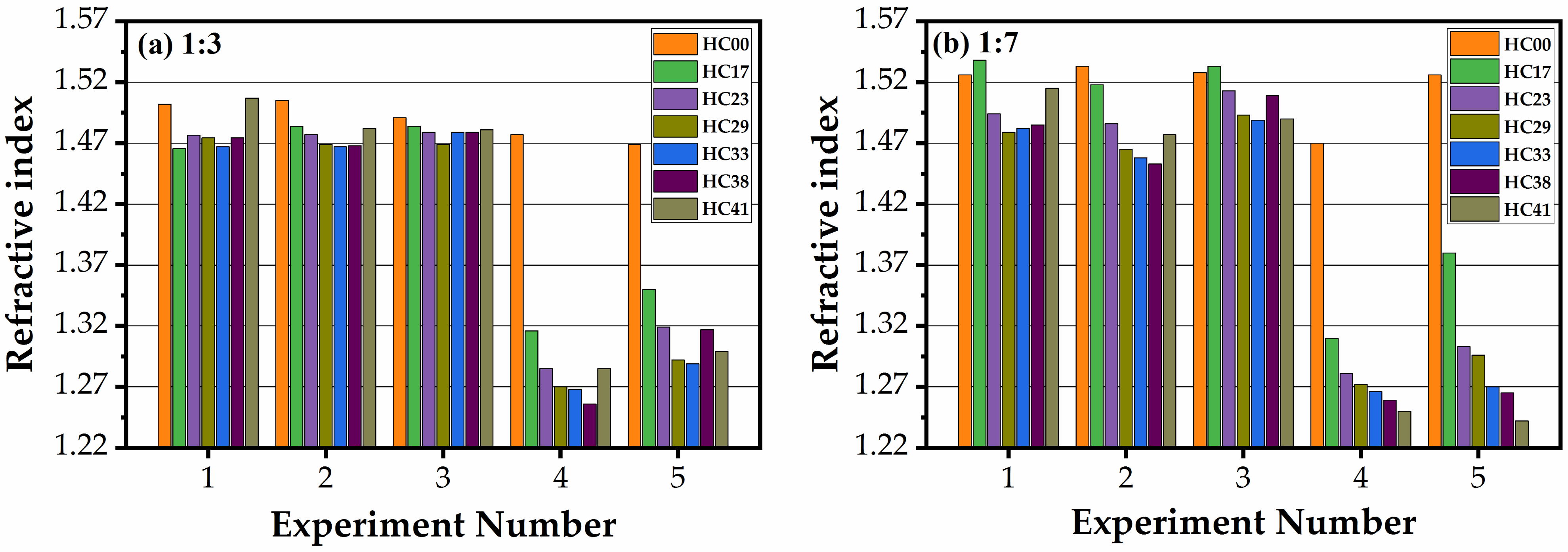
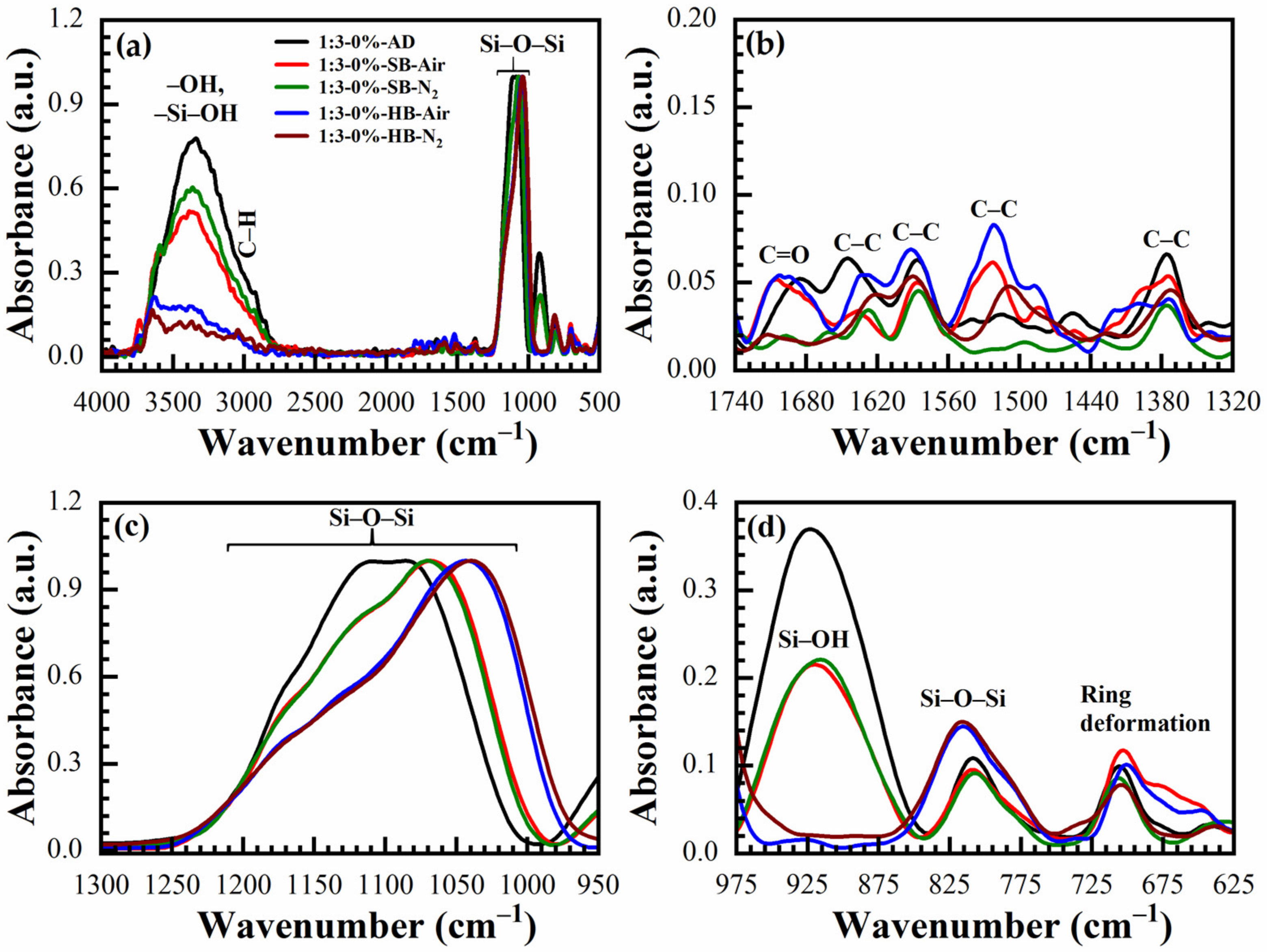
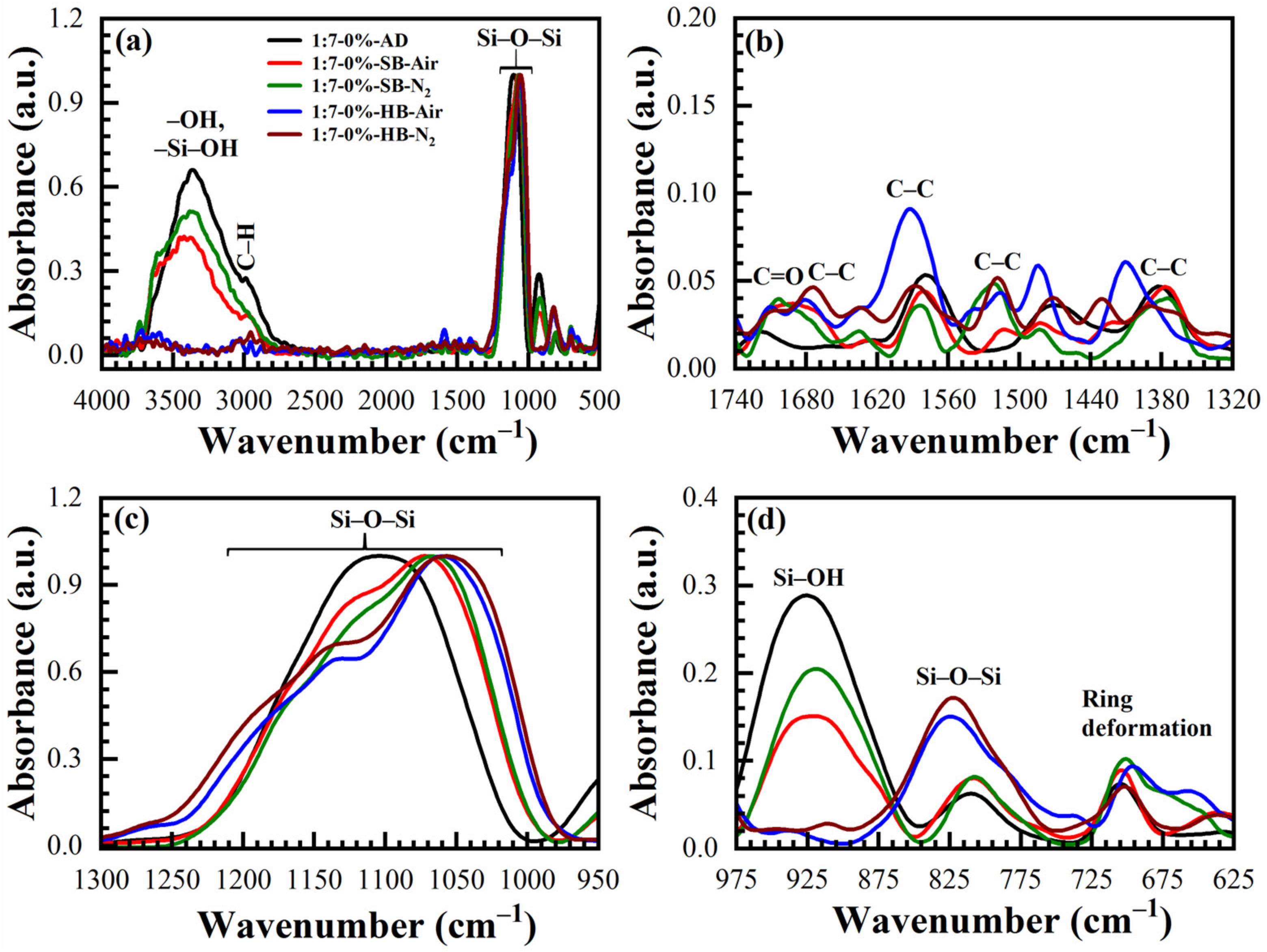

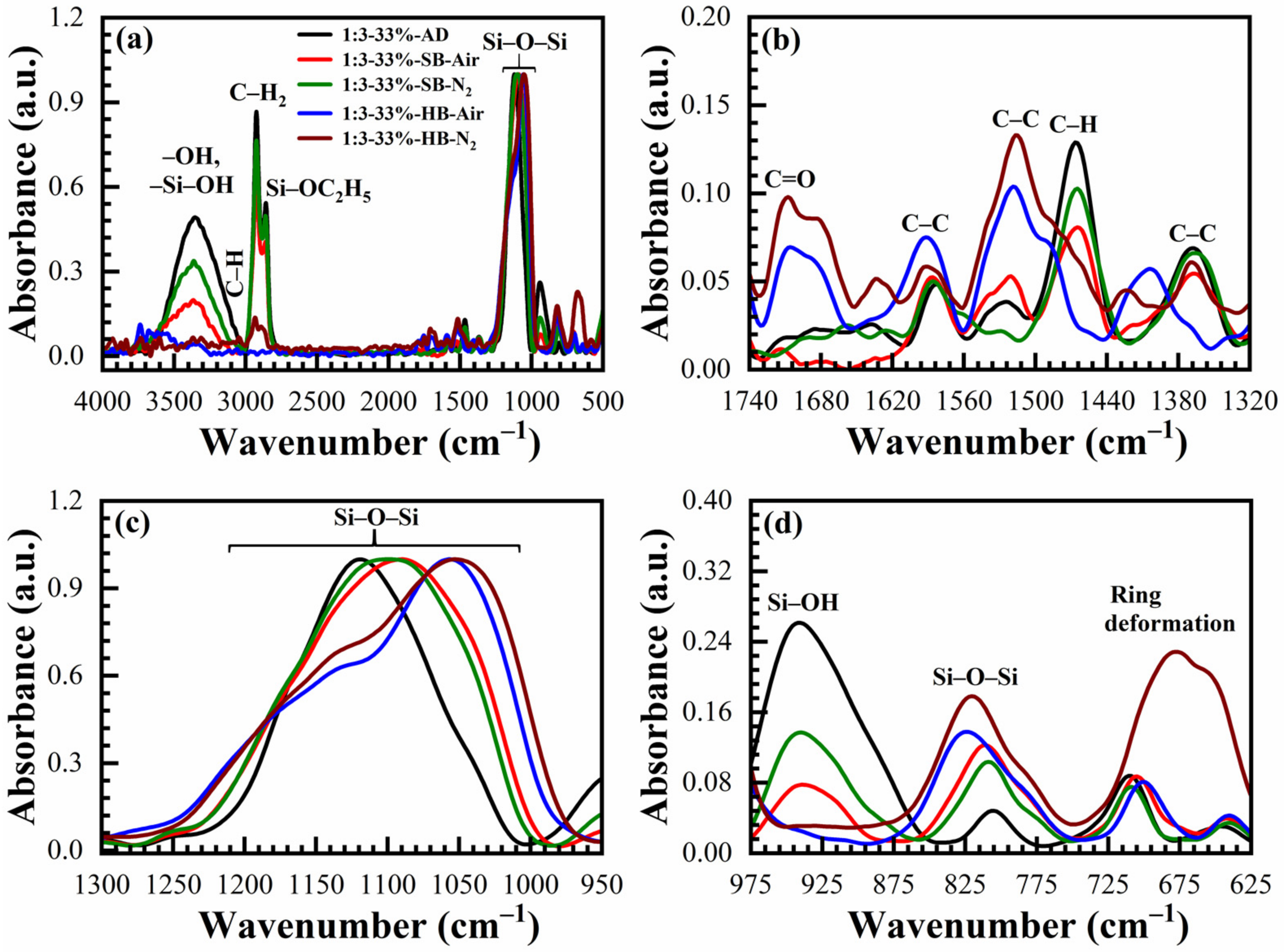


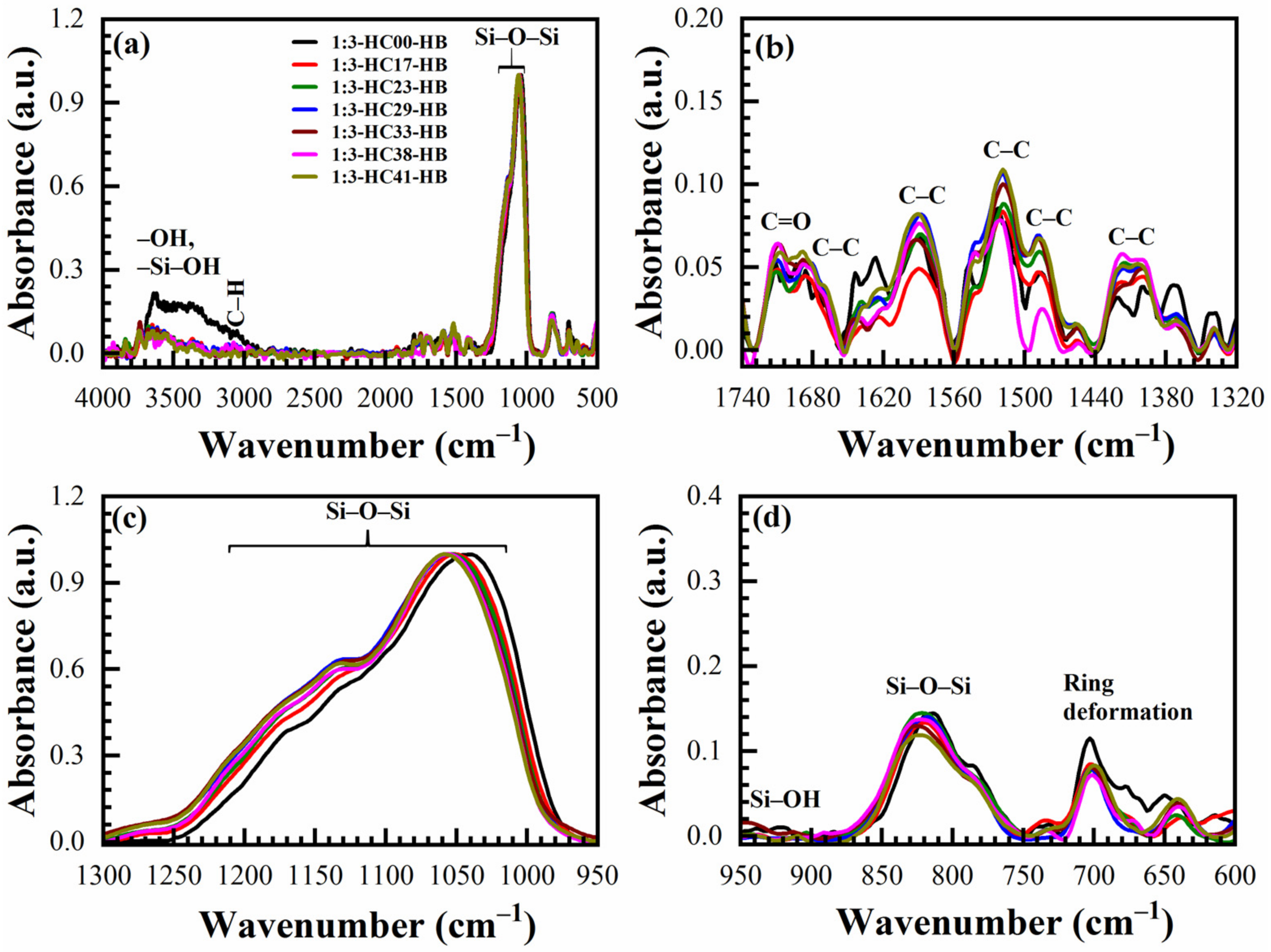
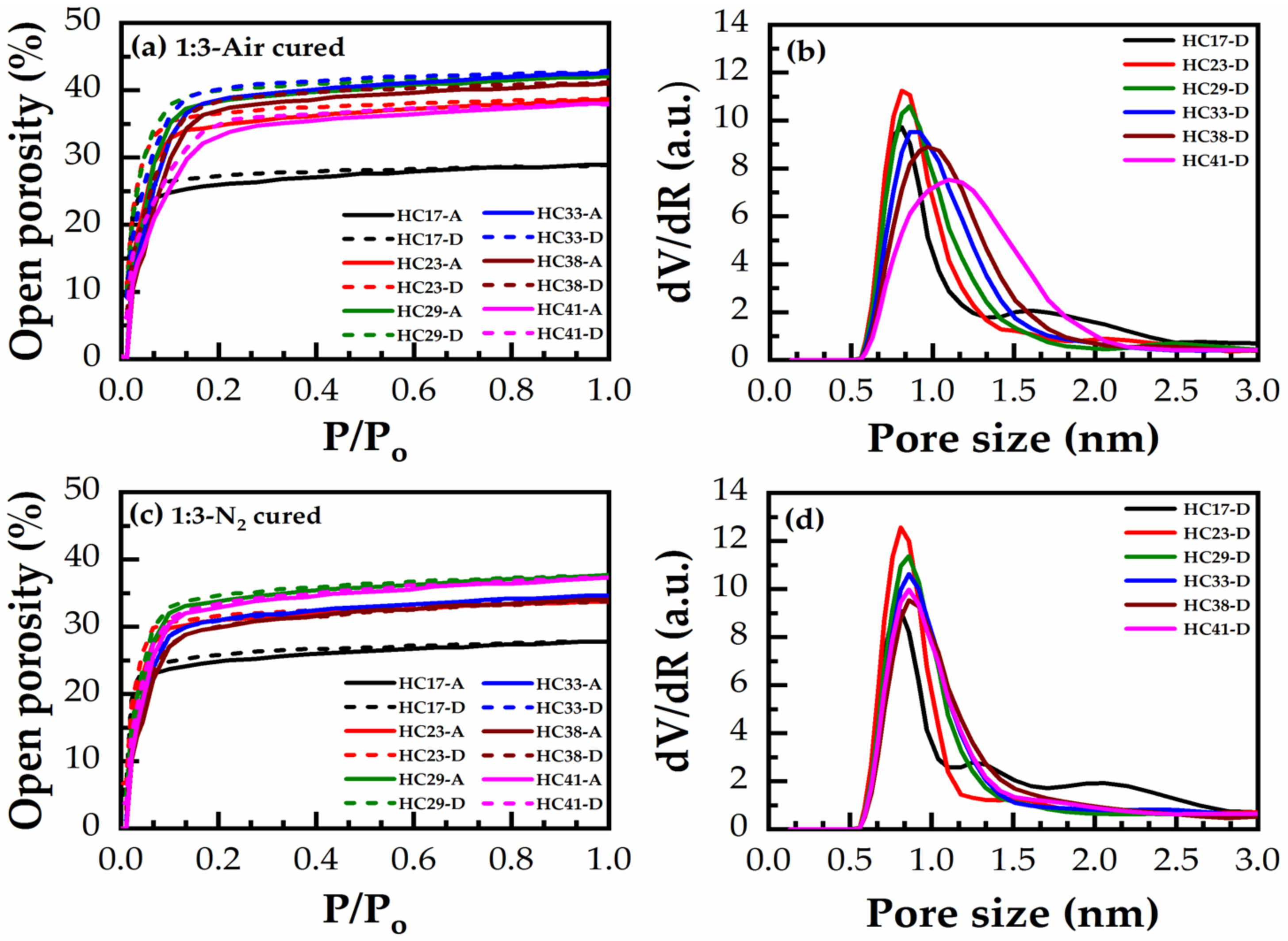

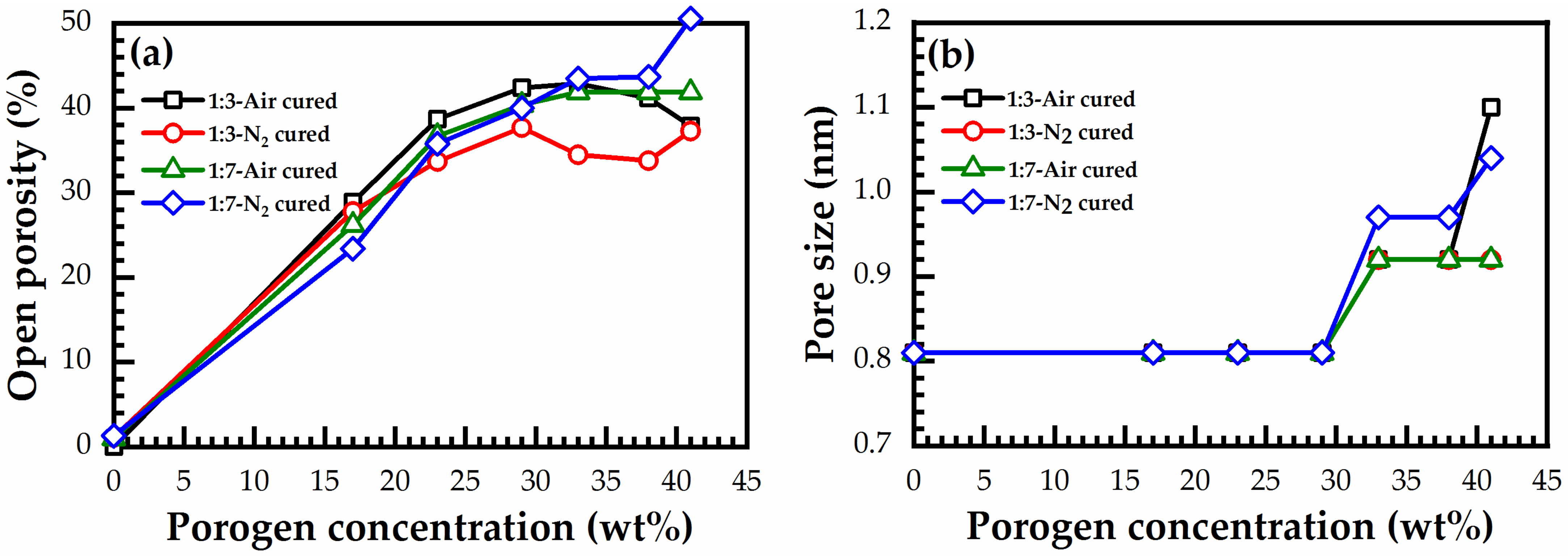
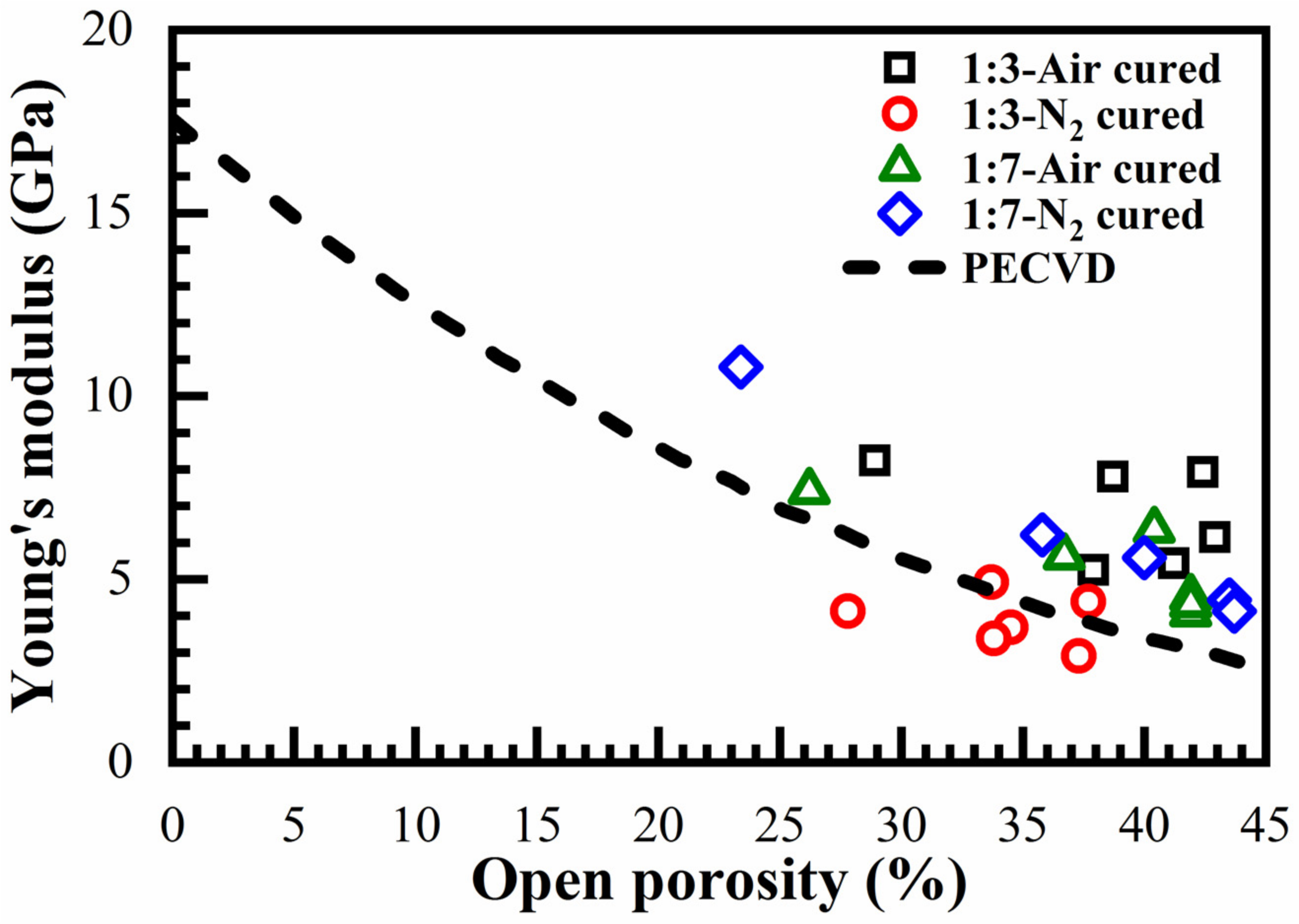
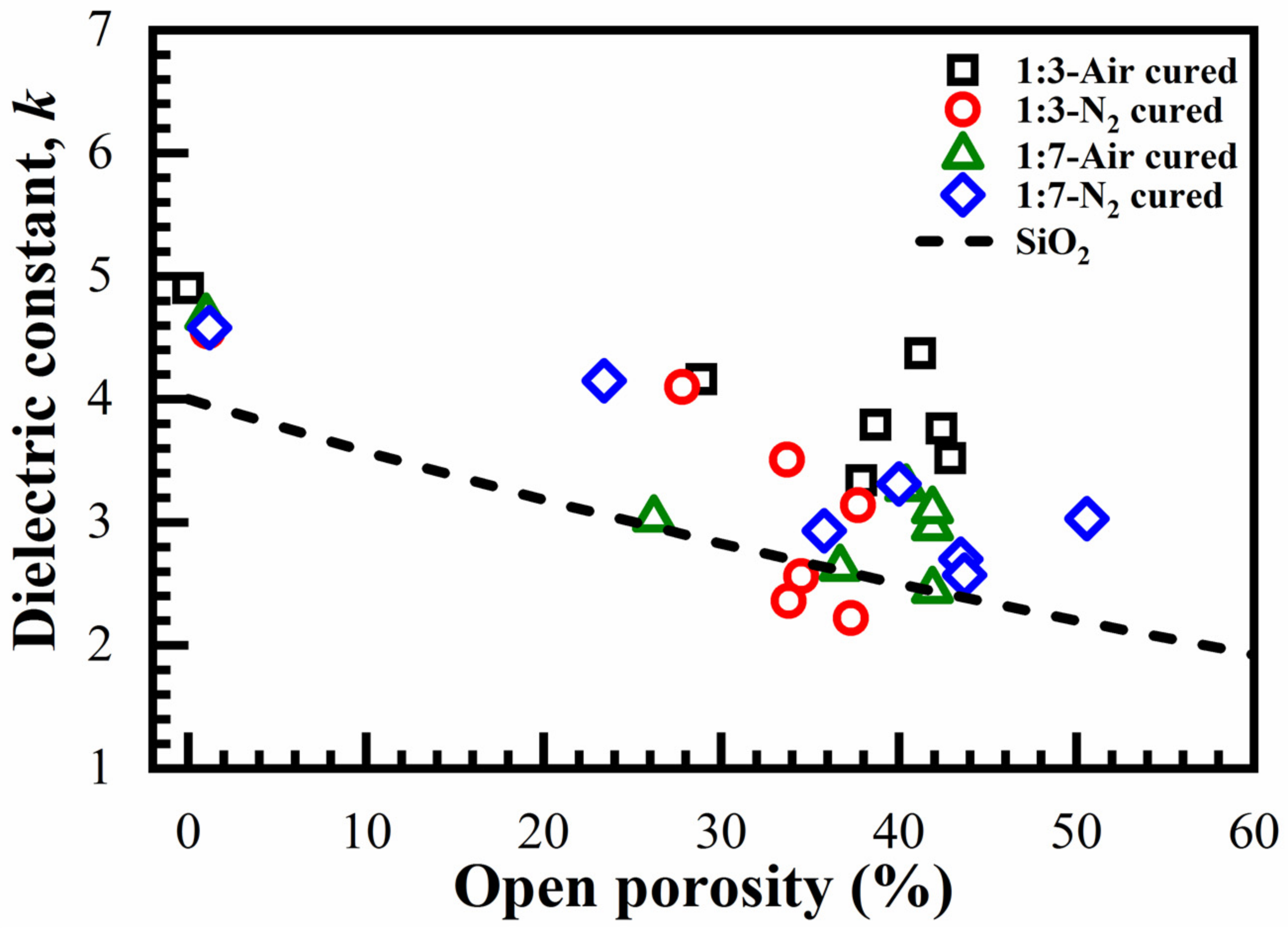

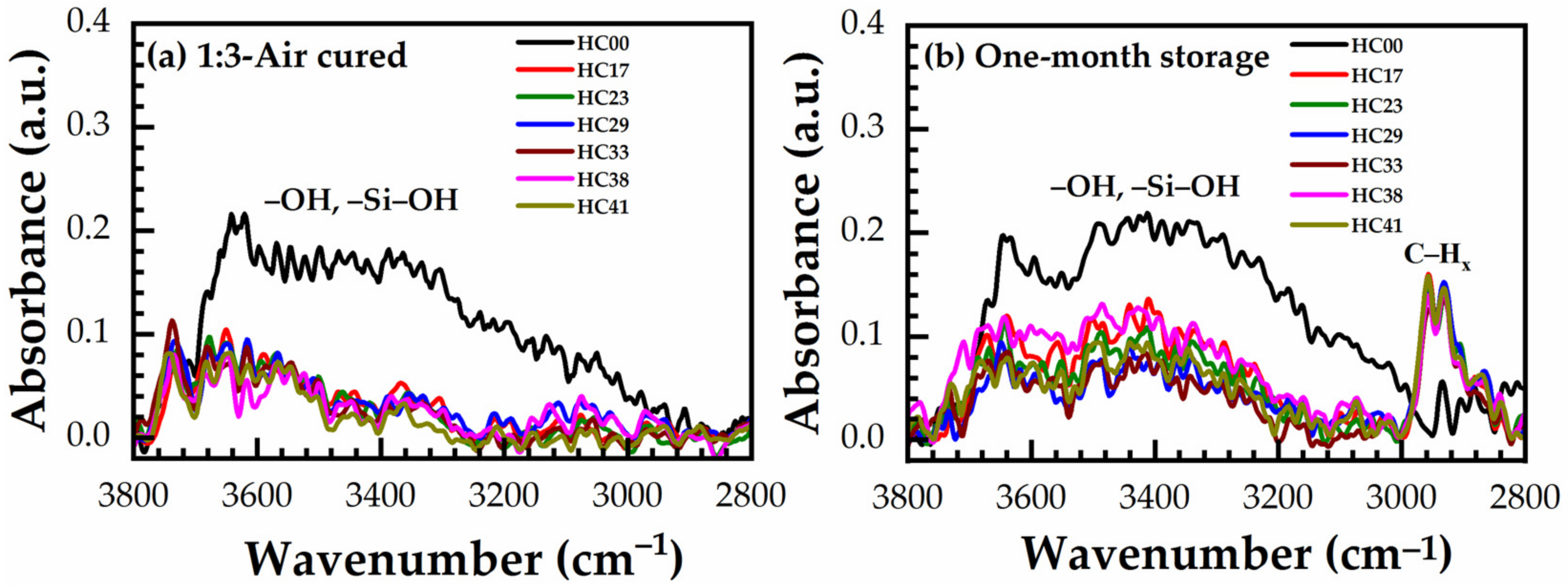


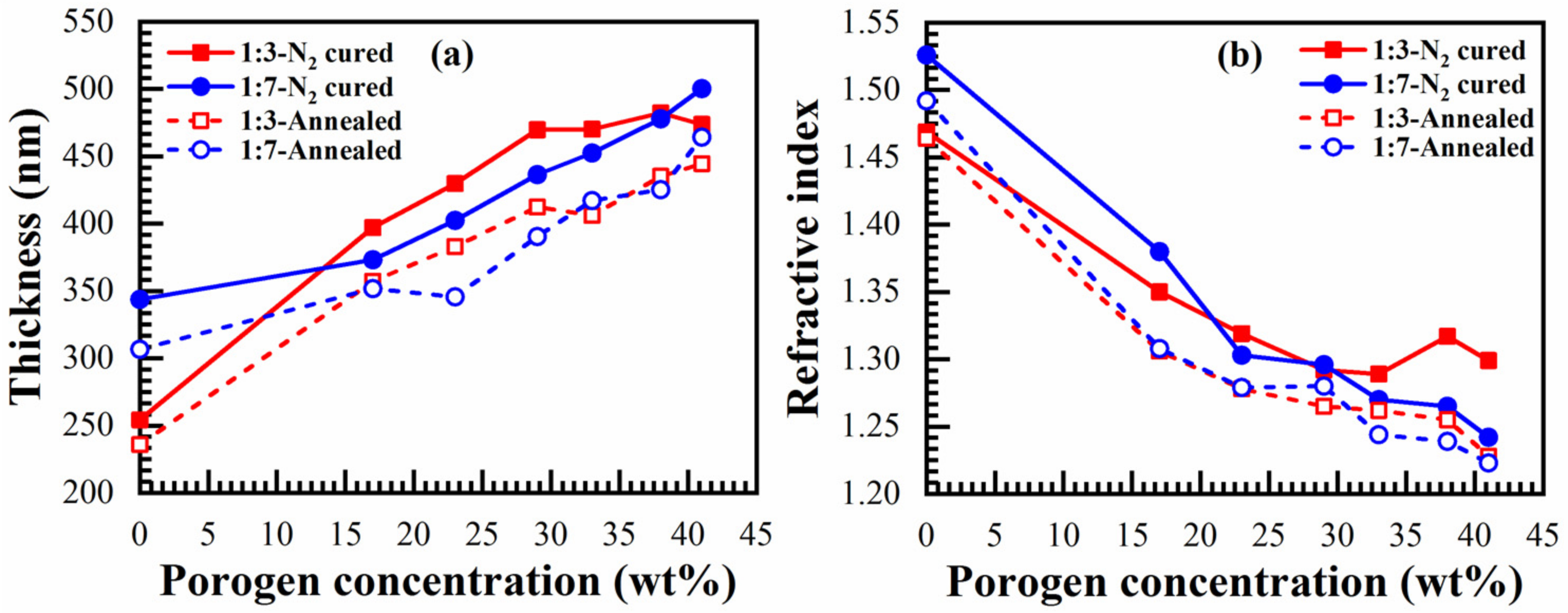
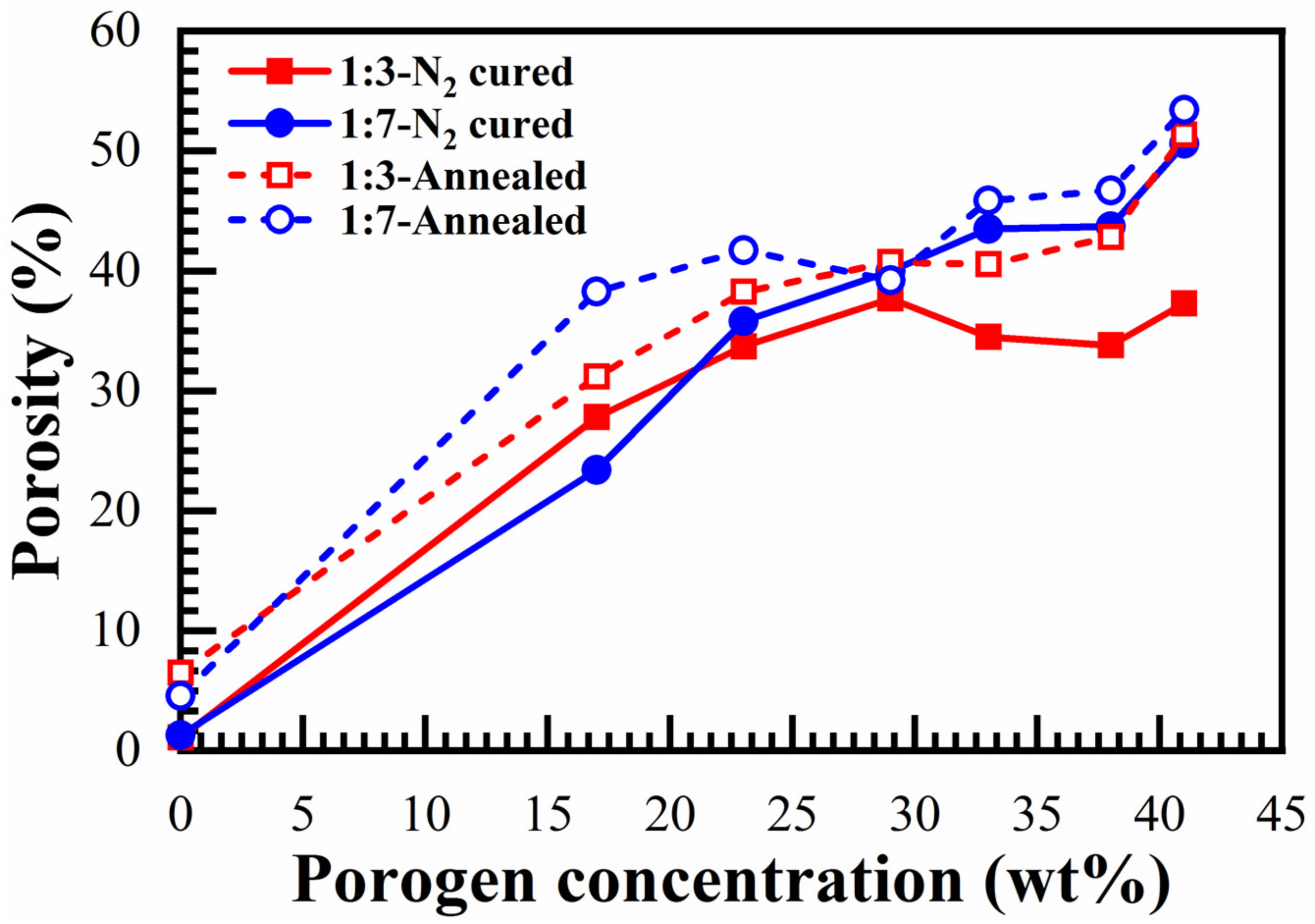
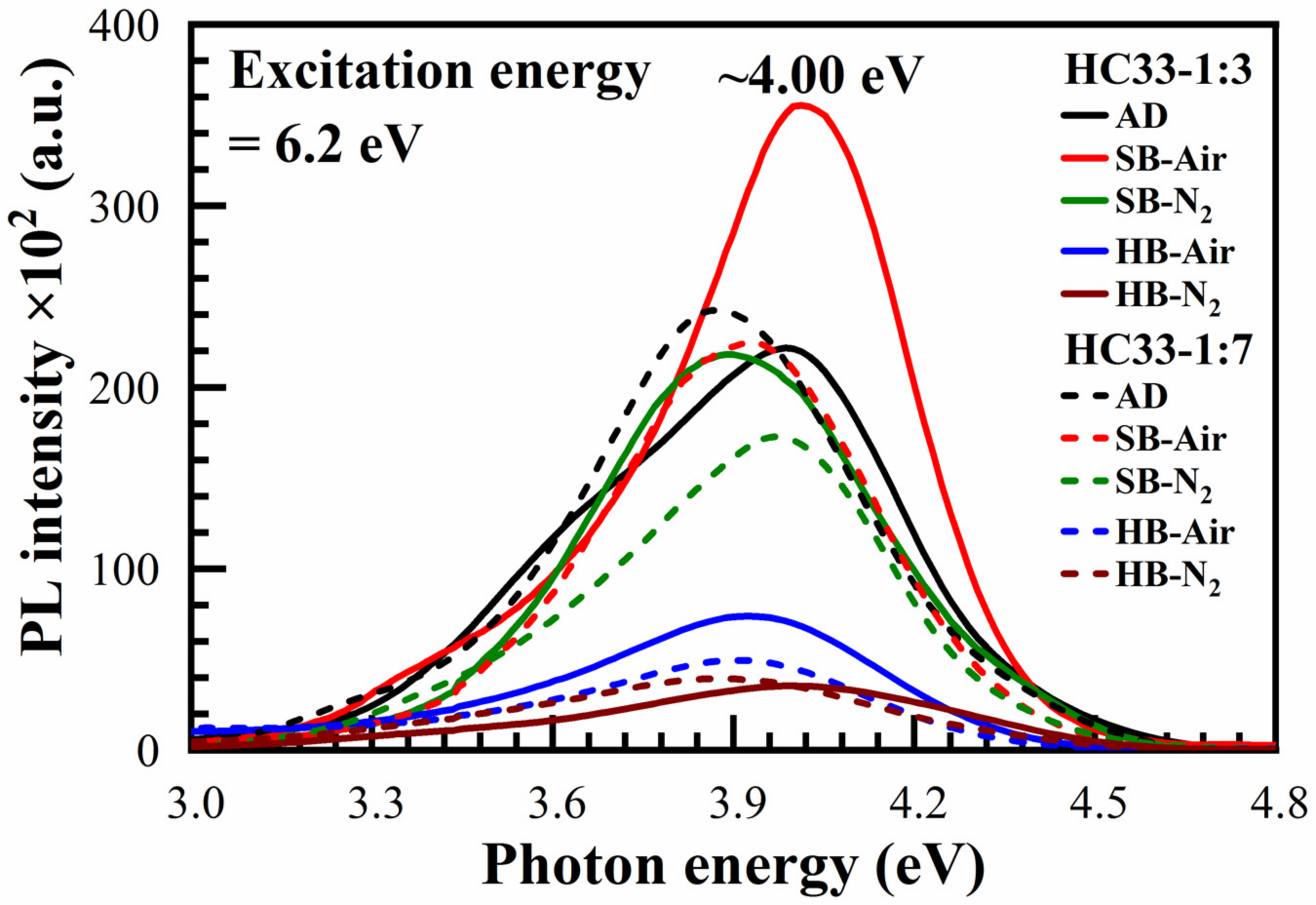
| Chemical Shift, δ (ppm) | Peak Assignment |
|---|---|
| 8.06 | 1,3,5-benzene (135TTEB) |
| 7.97 | 1,3-benzene (13BTEB) |
| 7.72 | 1,3-benzene (13BTEB) |
| 7.38 | 1,3-benzene (13BTEB) |
| 7.24 | CDCl3 |
| 3.83 | Methylene group of CH3–CH2–OSi |
| 1.22 | Methyl group of CH3–CH2–OSi |
| Sample Number | Status | As-Deposited (AD) | Soft Baked (SB) at 150 °C | Hard baked (HB) at 400 °C | ||||||||||
|---|---|---|---|---|---|---|---|---|---|---|---|---|---|---|
| d (nm) | RI | Porosity (%) | Pore Radius (nm) | WCA | YM from EP | k-Value | ||||||||
| d (nm) | RI | d (nm) | RI | Ads | Des | Ads | Des | |||||||
| HC00 | 1:3-Air | 315.3 | 1.501 | 280.5 | 1.505 | 254.9 | 1.477 | - | - | - | - | 75.52 | - | 4.90 |
| 1:3-N2 | 311.2 | 1.503 | 283.8 | 1.491 | 254.2 | 1.469 | - | - | - | - | 85.59 | - | 4.55 | |
| 1:7-Air | 366.6 | 1.526 | 333.4 | 1.533 | 315.7 | 1.470 | - | - | - | - | 61.68 | 9.98 | 6.46 | |
| 1:7-N2 | 427.9 | 1.520 | 379.9 | 1.528 | 343.7 | 1.526 | - | - | - | - | 90.46 | 11.05 | 5.59 | |
| HC17 | 1:3-Air | 537.2 | 1.453 | 415.0 | 1.484 | 356.4 | 1.316 | 28.9 | 28.9 | 0.81 | 0.81 | 46.54 | 8.232 | 4.16 |
| 1:3-N2 | 538.2 | 1.478 | 439.9 | 1.484 | 397.1 | 1.350 | 27.8 | 27.8 | 0.81 | 0.81 | 71.26 | 4.129 | 4.10 | |
| 1:7-Air | 454.1 | 1.538 | 396.3 | 1.518 | 377.7 | 1.324 | 26.2 | 26.2 | 0.81 | 0.81 | 50.25 | 7.41 | 3.03 | |
| 1:7-N2 | 459.7 | 1.533 | 390.4 | 1.557 | 373.2 | 1.330 | 23.4 | 23.4 | 0.81 | 0.81 | 62.62 | 10.80 | 4.15 | |
| HC23 | 1:3-Air | 641.0 | 1.475 | 486.2 | 1.477 | 402.5 | 1.285 | 38.5 | 38.7 | 0.92 | 0.81 | 58.60 | 7.795 | 3.79 |
| 1:3-N2 | 643 | 1.478 | 493.1 | 1.479 | 429.7 | 1.319 | 33.7 | 33.7 | 0.81 | 0.81 | 75.22 | 4.919 | 3.51 | |
| 1:7-Air | 572.4 | 1.494 | 456.8 | 1.486 | 401.9 | 1.281 | 36.7 | 36.7 | 0.81 | 0.81 | 47.43 | 5.62 | 2.62 | |
| 1:7-N2 | 541.4 | 1.512 | 431.6 | 1.513 | 402.4 | 1.303 | 35.8 | 35.8 | 0.81 | 0.81 | 72.73 | 6.21 | 2.93 | |
| HC29 | 1:3-Air | 724.6 | 1.477 | 516.6 | 1.469 | 420.1 | 1.270 | 42.1 | 42.4 | 0.92 | 0.81 | 59.10 | 7.921 | 3.76 |
| 1:3-N2 | 718.6 | 1.472 | 547.2 | 1.469 | 469.8 | 1.292 | 37.7 | 37.7 | 0.86 | 0.81 | 73.87 | 4.129 | 3.14 | |
| 1:7-Air | 658.6 | 1.479 | 479.5 | 1.465 | 405.4 | 1.272 | 40.4 | 40.4 | 0.92 | 0.81 | 48.84 | 6.35 | 3.29 | |
| 1:7-N2 | 657.6 | 1.489 | 506.0 | 1.493 | 436.4 | 1.296 | 40.0 | 40.0 | 0.86 | 0.81 | 75.96 | 5.59 | 3.31 | |
| HC33 | 1:3-Air | 815.4 | 1.464 | 543.6 | 1.467 | 416.3 | 1.268 | 42.6 | 42.9 | 0.92 | 0.92 | 57.53 | 6.142 | 3.52 |
| 1:3-N2 | 823.2 | 1.470 | 610.8 | 1.479 | 470.2 | 1.289 | 34.5 | 34.5 | 0.86 | 0.92 | 74.99 | 3.631 | 2.56 | |
| 1:7-Air | 727.7 | 1.482 | 488.0 | 1.458 | 401.5 | 1.266 | 41.9 | 41.9 | 0.92 | 0.92 | 51.09 | 4.51 | 2.96 | |
| 1:7-N2 | 737.1 | 1.482 | 523.5 | 1.489 | 452.5 | 1.270 | 43.5 | 43.5 | 0.97 | 0.97 | 71.96 | 4.43 | 2.7 | |
| HC38 | 1:3-Air | 903.9 | 1.474 | 557 | 1.468 | 413.3 | 1.256 | 41.0 | 41.2 | 0.92 | 0.92 | 58.57 | 5.432 | 4.37 |
| 1:3-N2 | 912.4 | 1.475 | 654.7 | 1.479 | 482.3 | 1.317 | 33.8 | 33.8 | 0.92 | 0.92 | 87.99 | 3.026 | 2.36 | |
| 1:7-Air | 816.8 | 1.485 | 501.5 | 1.453 | 419.3 | 1.259 | 41.9 | 41.9 | 0.92 | 0.92 | 52.00 | 4.07 | 3.11 | |
| 1:7-N2 | 848.4 | 1.48 | 563.8 | 1.509 | 477.9 | 1.265 | 43.7 | 43.7 | 0.97 | 0.97 | 74.27 | 4.13 | 2.57 | |
| HC41 | 1:3-Air | 949.4 | 1.510 | 568.6 | 1.482 | 398.9 | 1.285 | 38.0 | 37.9 | 1.25 | 1.10 | 60.74 | 5.248 | 3.34 |
| 1:3-N2 | 948.1 | 1.504 | 674.3 | 1.481 | 473.7 | 1.299 | 37.3 | 37.3 | 0.86 | 0.92 | 70.62 | 2.899 | 2.22 | |
| 1:7-Air | 927.7 | 1.515 | 531.9 | 1.477 | 425.0 | 1.250 | 41.9 | 41.9 | 0.92 | 0.92 | 53.96 | 4.31 | 2.45 | |
| 1:7-N2 | 918.3 | 1.521 | 623.4 | 1.49 | 500.3 | 1.242 | 50.6 | 50.6 | 1.04 | 1.04 | 77.38 | 2.95 | 3.03 | |
Publisher’s Note: MDPI stays neutral with regard to jurisdictional claims in published maps and institutional affiliations. |
© 2021 by the authors. Licensee MDPI, Basel, Switzerland. This article is an open access article distributed under the terms and conditions of the Creative Commons Attribution (CC BY) license (https://creativecommons.org/licenses/by/4.0/).
Share and Cite
Rasadujjaman, M.; Wang, X.; Wang, Y.; Zhang, J.; Arkhincheev, V.E.; Baklanov, M.R. Analytical Study of Porous Organosilicate Glass Films Prepared from Mixtures of 1,3,5- and 1,3-Alkoxysilylbenzenes. Materials 2021, 14, 1881. https://doi.org/10.3390/ma14081881
Rasadujjaman M, Wang X, Wang Y, Zhang J, Arkhincheev VE, Baklanov MR. Analytical Study of Porous Organosilicate Glass Films Prepared from Mixtures of 1,3,5- and 1,3-Alkoxysilylbenzenes. Materials. 2021; 14(8):1881. https://doi.org/10.3390/ma14081881
Chicago/Turabian StyleRasadujjaman, Md, Xuesong Wang, Yanrong Wang, Jing Zhang, Valeriy E. Arkhincheev, and Mikhail R. Baklanov. 2021. "Analytical Study of Porous Organosilicate Glass Films Prepared from Mixtures of 1,3,5- and 1,3-Alkoxysilylbenzenes" Materials 14, no. 8: 1881. https://doi.org/10.3390/ma14081881








